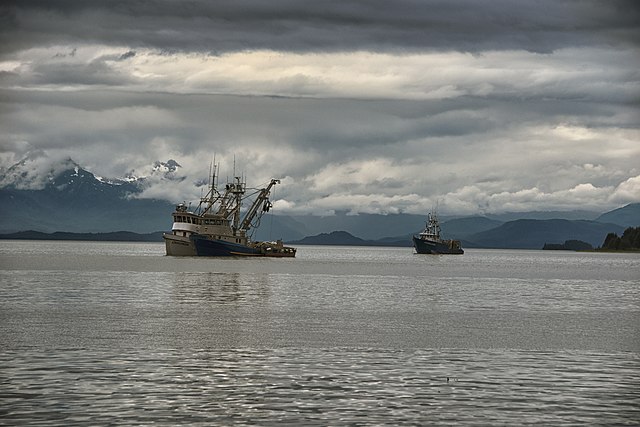Originally published September 18, 2024. Alaska fisheries, the largest by production volume in the United States, are increasingly experiencing production swings and court battles.
One front is a court case on stoppage of troll fishing and another front is the decline in chum salmon catches. The last mention is reminiscent of the 2018-2021 mysterious disappearance of 10 billion snow crabs in the state’s Bering Sea.
Doug Vincent-Lang, the commissioner of the Department of Fish and and Game (ADFG) summarized to National Fisherman how local fisheries are “besieged on many fronts.”
Chum Salmon Decline
The first battle line is the gradual reduction in chum salmon or Oncorhynchus keta. This is a deep-bodied salmon species that thrives from Alaska to Japan in the Pacific Ocean.
An April 2024 forecast by ADFG downsized salmon production to 135.7 million units from some 154.9 million units of 2023. Of this stock, chum salmon did not make the top 2 count by species, which pink salmon and sockeye salmon usurped.
Then on September 11, ADFG reported chum salmon production at 41,793 pounds, each with a wholesale value of $0.61 per pound.
The haul’s value of $25,091 was the least appeasing since 2002 due to tough market conditions.
At the height of the chum season in the years between 1962 and 2023, catches in just one district of Alaska usually averaged $728,025. This according to an analysis report by Undercurrent News.
Alaska Fisheries’ Trolling Case
Outside the chum salmon territory is a long running court battle to stop Alaska’s troll fishing and protect “orca” whales, which eat salmon.
It all began in May 2023 when Wild Fish Conservancy filed the case in Seattle, Washington, labeling the whale as endangered.
On August 16, 2024, the case got a new twist when fishermen won a first round. The Circuit Court of Appeals in California allowed trolling to continue until a natural alternative comes via the U.S. National Marine Service (NMFS).
Analysts now believe that the win could be temporal as the conservation group still aims to realize its goal to save the whale.
Troll fishing means catching salmon by baiting it with another fish from a boat pulls at a moderate speed. The method provides livelihood for 1,500 Alaskan fishermen, and is a considerable source of fishing income. Troll-caught fish, especially king salmon, usually carry more market value than those by other means.
The trolling season for Chinook salmon in southeast Alaska normally runs from early October to end March.
Chinook “Listing?”
Alaska fisheries however are not coping just with a decline in chum salmon production or troll fishing cases, but with chinook, too.
NMFS lifted eyebrows when it suggested that chinook may warrant “threatened listing”in its September 2024 finding.
Ultimately, fishing in Alaska remains on edge but this does not reduce its lead in American fishing. Full details on this lead are in the next statistics section.
Alaska Fisheries Statistics
Alaska leads American seafood production, especially fish, by volume. In 2022, the state’s 4.818 billion pounds of seafood was over four times above Louisiana’s second placement at 912 million pounds. Following suit was Virginia at 344 million pounds, then Mississippi and Oregon at 311 and 286 million pounds, respectively.
According to the National Oceanic and Atmospheric Authority (NOAA), Alaska also led 2019 commercial landings at 5.6 billion pounds worth $1.7 billion. Massachusetts (MA) followed 2019’s landings by sales value worth $679.3 million. However MA’s catch volume did not make the rest of the top five, which went to Louisiana, Washington, Virginia and Mississippi.
How do fishing ports in Alaska perform nationally?
3 of Alaska’s ports are often in the top 5 of all American port landings, according to NOAA. In 2019, Alaska’s Dutch Harbor, Aleutian Islands and Kodiak port topped America landings at 763 million pounds, 590 million pounds and 397 million pounds, respectively. Only New Bedford port in Massachusetts had more commercial value at $451 million pounds, although its volume was rather low at 116 million pounds.
Which fish does Alaska lead federal production?
Almost all of U.S.’ pollock production (exclusively Alaskan pollock species) comes from Alaska and hovers between 1.3 and 1.5 million tonnes. 700,000 tonnes or half of this annual output enjoys consumption within the U.S.
How many commercial salmon species are there in Alaska?
Of the six commercial salmon species, Alaska boasts five, which include chinook, pink, chum, sockeye and coho. Production of all types averages 858.5 million pounds annually with a value of $643.9 million, as of 2021.
